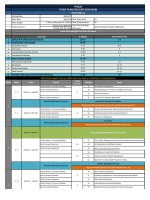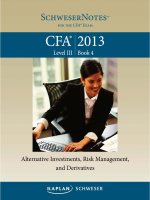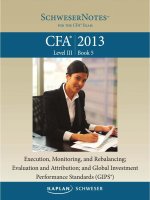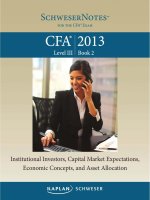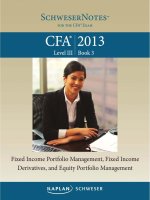2018 CFA level 2 study note book1 unprotected
Bạn đang xem bản rút gọn của tài liệu. Xem và tải ngay bản đầy đủ của tài liệu tại đây (11.33 MB, 428 trang )
Table of Contents
1.
2.
3.
4.
5.
6.
7.
8.
9.
10.
Getting Started Flyer
Table of Contents
Page List
Book 1: Ethical and Professional Standards, Quantitative Methods, and
Economics
Welcome to the 2017 Level II SchweserNotes™
Readings and Learning Outcome Statements
Code of Ethics and Standards of Professional Conduct
1. LOS 1.a: Describe the six components of the Code of Ethics and the seven
Standards of Professional Conduct.
2. LOS 1.b: Explain the ethical responsibilities required of CFA Institute
members and candidates in the CFA Program by the Code and Standards.
3. LOS 2.a: Demonstrate a thorough knowledge of the Code of Ethics and
Standards of Professional Conduct by applying the Code and Standards to
specific situations.
4. LOS 2.b: Recommend practices and procedures designed to prevent
violations of the Code of Ethics and Standards of Professional Conduct.
5. Key Concepts
1. LOS 1.a, b
6. Concept Checkers
1. Answers – Concept Checkers
CFA Institute Research Objectivity Standards
1. LOS 3.a: Explain the objectives of the Research Objectivity Standards.
2. LOS 3.b: Evaluate company policies and practices related to research
objectivity, and distinguish between changes required and changes
recommended for compliance with the Research Objectivity Standards.
3. Key Concepts
1. LOS 3.a
2. LOS 3.b
4. Concept Checkers
1. Answers – Concept Checkers
The Glenarm Company
1. LOS 4.a: Evaluate the practices and policies presented.
2. LOS 4.b: Explain the appropriate action to take in response to conduct that
violates the CFA Institute Code of Ethics and Standards of Professional
Conduct.
Preston Partners
1. LOS 5.a: Evaluate the practices and policies presented.
2. LOS 5.b: Explain the appropriate action to take in response to conduct that
violates the CFA Institute Code of Ethics and Standards of Professional
Conduct.
11. Super Selection
1. LOS 6.a: Evaluate the practices and policies presented.
2. LOS 6.b: Explain the appropriate action to take in response to conduct that
violates the CFA Institute Code of Ethics and Standards of Professional
Conduct.
12. Trade Allocation: Fair Dealing and Disclosure
1. LOS 7.a: Evaluate trade allocation practices and determine whether they
comply with the CFA Institute Standards of Professional Conduct
addressing fair dealing and client loyalty.
2. LOS 7.b: Describe appropriate actions to take in response to trade
allocation practices that do not adequately respect client interests.
13. Changing Investment Objectives
1. LOS 8.a: Evaluate the disclosure of investment objectives and basic policies
and determine whether they comply with the CFA Institute Standards of
Professional Conduct.
2. LOS 8.b: Describe appropriate actions needed to ensure adequate
disclosure of the investment process.
14. Self-Test: Ethics and Professional Standards
1. Self-Test Answers: Ethics and Professional Standards
15. Correlation and Regression
1. LOS 9.a: Calculate and interpret a sample covariance and a sample
correlation coefficient and interpret a scatter plot.
2. LOS 9.b: Describe limitations to correlation analysis.
3. LOS 9.c: Formulate a test of the hypothesis that the population correlation
coefficient equals zero and determine whether the hypothesis is rejected
at a given level of significance.
4. LOS 9.d: Distinguish between the dependent and independent variables in
a linear regression.
5. LOS 9.e: Describe the assumptions underlying linear regression and
interpret regression coefficients.
6. LOS 9.f: Calculate and interpret the standard error of estimate, the
coefficient of determination, and a confidence interval for a regression
coefficient.
7. LOS 9.g: Formulate a null and alternative hypothesis about a population
value of a regression coefficient and determine the appropriate test
statistic and whether the null hypothesis is rejected at a given level of
significance.
8. LOS 9.h: Calculate the predicted value for the dependent variable, given an
estimated regression model and a value for the independent variable.
9. LOS 9.i: Calculate and interpret a confidence interval for the predicted
value of the dependent variable.
10. LOS 9.j: Describe the use of analysis of variance (ANOVA) in regression
analysis, interpret ANOVA results, and calculate and interpret the F-
statistic.
11. LOS 9.k: Describe limitations of regression analysis.
12. Key Concepts
1. LOS 9.a
2. LOS 9.b
3. LOS 9.c
4. LOS 9.d
5. LOS 9.e
6. LOS 9.f
7. LOS 9.g
8. LOS 9.h
9. LOS 9.i
10. LOS 9.j
11. LOS 9.k
13. Concept Checkers
1. Answers – Concept Checkers
14. Challenge Problems
1. Answers – Challenge Problems
16. Multiple Regression and Issues in Regression Analysis
1. LOS 10.a: Formulate a multiple regression equation to describe the relation
between a dependent variable and several independent variables and
determine the statistical significance of each independent variable.
2. LOS 10.b: Interpret estimated regression coefficients and their p-values.
3. LOS 10.c: Formulate a null and an alternative hypothesis about the
population value of a regression coefficient, calculate the value of the test
statistic, and determine whether to reject the null hypothesis at a given
level of significance.
4. LOS 10.d: Interpret the results of hypothesis tests of regression
coefficients.
5. LOS 10.e: Calculate and interpret 1) a confidence interval for the
population value of a regression coefficient and 2) a predicted value for the
dependent variable, given an estimated regression model and assumed
values for the independent variables.
6. LOS 10.f: Explain the assumptions of a multiple regression model.
7. LOS 10.g: Calculate and interpret the F-statistic, and describe how it is used
in regression analysis.
8. LOS 10.h: Distinguish between and interpret the R2 and adjusted R2 in
multiple regression.
9. LOS 10.i: Evaluate how well a regression model explains the dependent
variable by analyzing the output of the regression equation and an ANOVA
table.
10. LOS 10.j: Formulate a multiple regression equation by using dummy
variables to represent qualitative factors and interpret the coefficients and
regression results.
11. LOS 10.k: Explain the types of heteroskedasticity and how
heteroskedasticity and serial correlation affect statistical inference.
12. LOS 10.l: Describe multicollinearity and explain its causes and effects in
regression analysis.
13. LOS 10.m: Describe how model misspecification affects the results of a
regression analysis and describe how to avoid common forms of
misspecification.
14. LOS 10.n: Describe models with qualitative dependent variables.
15. LOS 10.o: Evaluate and interpret a multiple regression model and its
results.
16. Key Concepts
1. LOS 10.a
2. LOS 10.b
3. LOS 10.c
4. LOS 10.d
5. LOS 10.e
6. LOS 10.f
7. LOS 10.g
8. LOS 10.h
9. LOS 10.i
10. LOS 10.j
11. LOS 10.k, l
12. LOS 10.m
13. LOS 10.n
14. LOS 10.o
17. Concept Checkers
1. Answers – Concept Checkers
18. Challenge Problems
1. Answers – Challenge Problems
17. Time-Series Analysis
1. LOS 11.a: Calculate and evaluate the predicted trend value for a time
series, modeled as either a linear trend or a log-linear trend, given the
estimated trend coefficients.
2. LOS 11.b: Describe factors that determine whether a linear or a log-linear
trend should be used with a particular time series and evaluate limitations
of trend models.
3. LOS 11.c: Explain the requirement for a time series to be covariance
stationary and describe the significance of a series that is not stationary.
4. LOS 11.d: Describe the structure of an autoregressive (AR) model of order p
and calculate one- and two-period-ahead forecasts given the estimated
coefficients.
5. LOS 11.e: Explain how autocorrelations of the residuals can be used to test
whether the autoregressive model fits the time series.
6. LOS 11.f: Explain mean reversion and calculate a mean-reverting level.
7. LOS 11.g: Contrast in-sample and out-of-sample forecasts and compare the
forecasting accuracy of different time-series models based on the root
mean squared error criterion.
8. LOS 11.h: Explain the instability of coefficients of time-series models.
9. LOS 11.i: Describe characteristics of random walk processes and contrast
them to covariance stationary processes.
10. LOS 11.j: Describe implications of unit roots for time-series analysis, explain
when unit roots are likely to occur and how to test for them, and
demonstrate how a time series with a unit root can be transformed so it
can be analyzed with an AR model.
11. LOS 11.k: Describe the steps of the unit root test for nonstationarity and
explain the relation of the test to autoregressive time-series models.
12. LOS 11.l: Explain how to test and correct for seasonality in a time-series
model and calculate and interpret a forecasted value using an AR model
with a seasonal lag.
13. LOS 11.m: Explain autoregressive conditional heteroskedasticity (ARCH)
and describe how ARCH models can be applied to predict the variance of a
time series.
14. LOS 11.n: Explain how time-series variables should be analyzed for
nonstationarity and/or cointegration before use in a linear regression.
15. LOS 11.o: Determine an appropriate time-series model to analyze a given
investment problem and justify that choice.
16. Key Concepts
1. LOS 11.a
2. LOS 11.b
3. LOS 11.c
4. LOS 11.d
5. LOS 11.e
6. LOS 11.f
7. LOS 11.g
8. LOS 11.h
9. LOS 11.i
10. LOS 11.j
11. LOS 11.k
12. LOS 11.l
13. LOS 11.m
14. LOS 11.n
15. LOS 11.o
17. Concept Checkers
1. Answers – Concept Checkers
18. Probabilistic Approaches: Scenario Analysis, Decision Trees, and Simulations
1. LOS 12.a: Describe steps in running a simulation.
2. LOS 12.b: Explain three ways to define the probability distributions for a
simulation’s variables.
X VY
3.
4.
5.
6.
7.
8.
LOS 12.c: Describe how to treat correlation across variables in a simulation.
LOS 12.d: Describe advantages of using simulations in decision making.
LOS 12.e: Describe some common constraints introduced into simulations.
LOS 12.f: Describe issues in using simulations in risk assessment.
LOS 12.g: Compare scenario analysis, decision trees, and simulations.
Key Concepts
1. LOS 12.a
2. LOS 12.b
3. LOS 12.c
4. LOS 12.d
5. LOS 12.e
6. LOS 12.f
7. LOS 12.g
9. Concept Checkers
1. Answers – Concept Checkers
19. Self-Test: Quantitative Methods for Valuation
1. Self-Test Answers: Quantitative Methods for Valuation
20. Currency Exchange Rates: Understanding Equilibrium Value
1. LOS 13.a: Calculate and interpret the bid–offer spread on a spot or forward
currency quotation and describe the factors that affect the bid–offer
spread.
2. LOS 13.b: Identify a triangular arbitrage opportunity and calculate its profit,
given the bid–offer quotations for three currencies.
3. LOS 13.c: Distinguish between spot and forward rates and calculate the
forward premium/discount for a given currency.
4. LOS 13.d: Calculate the mark-to-market value of a forward contract.
5. LOS 13.e: Explain international parity conditions (covered and uncovered
interest rate parity, forward rate parity, purchasing power parity, and the
international Fisher effect).
6. LOS 13.f: Describe relations among the international parity conditions.
7. LOS 13.g: Evaluate the use of the current spot rate, the forward rate,
purchasing power parity, and uncovered interest parity to forecast future
spot exchange rates.
8. LOS 13.h: Explain approaches to assessing the long-run fair value of an
exchange rate.
9. LOS 13.i: Describe the carry trade and its relation to uncovered interest
rate parity and calculate the profit from a carry trade.
10. LOS 13.j: Explain how flows in the balance of payment accounts affect
currency exchange rates.
11. LOS 13.k: Explain the potential effects of monetary and fiscal policy on
exchange rates.
12. LOS 13.l: Describe objectives of central bank or government intervention
and capital controls and describe the effectiveness of intervention and
capital controls.
13. LOS 13.m: Describe warning signs of a currency crisis.
14. Key Concepts
1. LOS 13.a
2. LOS 13.b
3. LOS 13.c
4. LOS 13.d
5. LOS 13.e
6. LOS 13.f
7. LOS 13.g, h
8. LOS 13.i
9. LOS 13.j
10. LOS 13.k
11. LOS 13.l
12. LOS 13.m
15. Concept Checkers
1. Answers – Concept Checkers
16. Challenge Problems
1. Answers – Challenge Problems
21. Economic Growth and the Investment Decision
1. LOS 14.a: Compare factors favoring and limiting economic growth in
developed and developing economies.
2. LOS 14.b: Describe the relation between the long-run rate of stock market
appreciation and the sustainable growth rate of the economy.
3. LOS 14.c: Explain why potential GDP and its growth rate matter for equity
and fixed income investors.
4. LOS 14.d: Distinguish between capital deepening investment and
technological progress and explain how each affects economic growth and
labor productivity.
5. LOS 14.e: Forecast potential GDP based on growth accounting relations.
6. LOS 14.f: Explain how natural resources affect economic growth and
evaluate the argument that limited availability of natural resources
constrains economic growth.
7. LOS 14.g: Explain how demographics, immigration, and labor force
participation affect the rate and sustainability of economic growth.
8. LOS 14.h: Explain how investment in physical capital, human capital, and
technological development affects economic growth.
9. LOS 14.i: Compare classical growth theory, neoclassical growth theory, and
endogenous growth theory.
10. LOS 14.j: Explain and evaluate convergence hypotheses.
11. LOS 14.k: Describe the economic rationale for governments to provide
incentives to private investment in technology and knowledge.
12. LOS 14.l: Describe the expected impact of removing trade barriers on
capital investment and profits, employment and wages, and growth in the
economies involved.
22.
23.
24.
25.
13. Key Concepts
1. LOS 14.a
2. LOS 14.b
3. LOS 14.c
4. LOS 14.d
5. LOS 14.e
6. LOS 14.f
7. LOS 14.g
8. LOS 14.h
9. LOS 14.i
10. LOS 14.j
11. LOS 14.k
12. LOS 14.l
14. Concept Checkers
1. Answers – Concept Checkers
Economics of Regulation
1. LOS 15.a: Describe classifications of regulations and regulators.
2. LOS 15.b: Describe uses of self-regulation in financial markets.
3. LOS 15.c: Describe the economic rationale for regulatory intervention.
4. LOS 15.d: Describe regulatory interdependencies and their effects.
5. LOS 15.e: Describe tools of regulatory intervention in markets.
6. LOS 15.f: Explain purposes in regulating commerce and financial markets.
7. LOS 15.g: Describe anticompetitive behaviors targeted by antitrust laws
globally and evaluate the antitrust risk associated with a given business
strategy.
8. LOS 15.h: Describe benefits and costs of regulation.
9. LOS 15.i: Evaluate how a specific regulation affects an industry, company,
or security.
10. Key Concepts
1. LOS 15.a
2. LOS 15.b
3. LOS 15.c
4. LOS 15.d
5. LOS 15.e
6. LOS 15.f
7. LOS 15.g
8. LOS 15.h
9. LOS 15.i
11. Concept Checkers
1. Answers – Concept Checkers
Self-Test: Economics for Valuation
1. Self-Test Answers: Economics for Valuation
Formulas
Appendix A: Student’s T-Distribution
26.
27.
28.
29.
30.
Appendix B: F-Table at 5 Percent (Upper Tail)
Appendix C: F-Table at 2.5 Percent (Upper Tail)
Appendix D: Chi-Squared Table
Appendix E: Critical Values for the Durbin-Watson Statistic
Copyright
Page List
1.
2.
3.
4.
5.
6.
7.
8.
9.
10.
11.
12.
13.
14.
15.
16.
17.
18.
19.
20.
21.
22.
23.
24.
25.
26.
27.
28.
29.
30.
31.
32.
33.
34.
35.
36.
37.
38.
i
iii
iv
v
vi
vii
viii
ix
x
xi
xii
xiii
1
2
3
4
5
6
7
8
9
10
11
12
13
14
15
16
17
18
19
20
21
22
23
24
25
26
39.
40.
41.
42.
43.
44.
45.
46.
47.
48.
49.
50.
51.
52.
53.
54.
55.
56.
57.
58.
59.
60.
61.
62.
63.
64.
65.
66.
67.
68.
69.
70.
71.
72.
73.
74.
75.
76.
77.
78.
79.
80.
81.
82.
27
28
29
30
31
32
33
34
35
36
37
38
39
40
41
42
43
44
45
46
47
48
49
50
51
52
53
54
55
56
57
58
59
60
61
62
63
64
65
66
67
68
69
70
83.
84.
85.
86.
87.
88.
89.
90.
91.
92.
93.
94.
95.
96.
97.
98.
99.
100.
101.
102.
103.
104.
105.
106.
107.
108.
109.
110.
111.
112.
113.
114.
115.
116.
117.
118.
119.
120.
121.
122.
123.
124.
125.
126.
71
72
73
74
75
76
77
78
79
80
81
82
83
84
85
86
87
88
89
90
91
92
93
94
95
96
97
98
99
100
101
102
103
104
105
106
107
108
109
110
111
112
113
114
127.
128.
129.
130.
131.
132.
133.
134.
135.
136.
137.
138.
139.
140.
141.
142.
143.
144.
145.
146.
147.
148.
149.
150.
151.
152.
153.
154.
155.
156.
157.
158.
159.
160.
161.
162.
163.
164.
165.
166.
167.
168.
169.
170.
115
116
117
118
119
120
121
122
123
124
125
126
127
128
129
130
131
132
133
134
135
136
137
138
139
140
141
142
143
144
145
146
147
148
149
150
151
152
153
154
155
156
157
158
171.
172.
173.
174.
175.
176.
177.
178.
179.
180.
181.
182.
183.
184.
185.
186.
187.
188.
189.
190.
191.
192.
193.
194.
195.
196.
197.
198.
199.
200.
201.
202.
203.
204.
205.
206.
207.
208.
209.
210.
211.
212.
213.
214.
159
160
161
162
163
164
165
166
167
168
169
170
171
172
173
174
175
176
177
178
179
180
181
182
183
184
185
186
187
188
189
190
191
192
193
194
195
196
197
198
199
200
201
202
215.
216.
217.
218.
219.
220.
221.
222.
223.
224.
225.
226.
227.
228.
229.
230.
231.
232.
233.
234.
235.
236.
237.
238.
239.
240.
241.
242.
243.
244.
245.
246.
247.
248.
249.
250.
251.
252.
253.
254.
255.
256.
257.
258.
203
204
205
206
207
208
209
210
211
212
213
214
215
216
217
218
219
220
221
222
223
224
225
226
227
228
229
230
231
232
233
234
235
236
237
238
239
240
241
242
243
244
245
246
259.
260.
261.
262.
263.
264.
265.
266.
267.
268.
269.
270.
271.
272.
273.
274.
275.
276.
277.
278.
279.
280.
281.
282.
283.
284.
285.
286.
287.
288.
289.
290.
291.
292.
293.
294.
295.
296.
297.
298.
299.
300.
301.
302.
247
248
249
250
251
252
253
254
255
256
257
258
259
260
261
262
263
264
265
266
267
268
269
270
271
272
273
274
275
276
277
278
279
280
281
282
283
284
285
286
287
288
289
290
303.
304.
305.
306.
307.
308.
309.
310.
311.
312.
313.
314.
315.
316.
317.
318.
319.
320.
321.
322.
323.
324.
325.
326.
327.
328.
329.
330.
331.
332.
333.
334.
335.
336.
337.
338.
339.
340.
341.
342.
343.
291
292
293
294
295
296
297
298
299
300
301
302
303
304
305
306
307
308
309
310
311
312
313
314
315
316
317
318
319
320
321
322
323
324
325
326
327
328
329
330
331
BOOK 1 – ETHICAL AND PROFESSIONAL STANDARDS,
QUANTITATIVE METHODS, AND ECONOMICS
Readings and Learning Outcome Statements
Study Session 1 – Ethical and Professional Standards
Study Session 2 – Ethical and Professional Standards: Application
Self-Test: Ethical and Professional Standards
Study Session 3 – Quantitative Methods for Valuation
Self-Test: Quantitative Methods for Valuation
Study Session 4 – Economics for Valuation
Self-Test: Economics for Valuation
Formulas
Appendices
WELCOME TO THE 2017 LEVEL II
SCHWESERNOTES™
Thank you for trusting Kaplan Schweser to help you reach your goals. We are pleased
that you have chosen us to assist you in preparing for the Level II CFA Exam. In this
introduction, I want to explain the resources included with these SchweserNotes,
suggest how you can best use Schweser materials to prepare for the exam, and direct
you toward other educational resources you will find helpful as you study for the
exam.
Besides the SchweserNotes themselves, there are many educational resources
available at Schweser.com. Log in using the individual username and password that
you received when you purchased your SchweserNotes.
SchweserNotes™
These notes consist of five volumes that include complete coverage of all 17 Study
Sessions and all 465 Learning Outcome Statements (LOS). Examples, Concept Checkers
(multiple-choice questions), and Challenge Problems are provided along the way, to
help you master the material and check your progress. At the end of each major topic
area, you can take a self-test for that topic area. Self-test questions are created to be
exam-like in format and difficulty, to help you evaluate how well your study of each
topic has prepared you for the actual exam.
Practice Questions
Studies have shown that to retain what you learn, it is essential that you quiz yourself
often. For this purpose we offer SchweserPro™ QBank, which contains thousands of
Level II practice questions and explanations. Questions are available for each LOS,
topic, and Study Session. Build your own quizzes by specifying the topics and the
number of questions. SchweserPro QBank is an important learning aid for achieving
the depth of proficiency needed at Level II. It should not, however, be considered a
replacement for rehearsing with “exam-type” questions as found in our Practice
Exams, Volumes 1 & 2 and our Schweser Mock Exam.
Practice Exams
Schweser offers six full 6-hour practice exams: Schweser Practice Exams Volume 1 and
Volume 2 each contain three complete 120-question tests. These are important tools
for gaining the speed and skills you will need to pass the exam. Each book provides
answers with full explanations for self-grading and evaluation. By entering your
answers at Schweser.com, you can use our Performance Tracker to find out how you
are performing compared to other Schweser Level II candidates.
Schweser Candidate Resource Library
X VY
We have created a number of online reference videos, which are available to all
purchasers of Schweser Premium Instruction and PremiumPlus packages. Schweser
Candidate Resource Library videos range from 20 to 60 minutes in length and cover
such topics as: “Introduction to Item Sets,” “Hypothesis Testing,” “Foreign Exchange
Basics,” “Ratio Analysis,” and “Forward Contracts.”
Online Schweser Study Calendar
Select the date when you will start and what days of the week you can study, and the
online Schweser Study Calendar will create a study plan just for you, breaking each
study session into daily and weekly tasks to keep you on track and help you monitor
your progress through the curriculum.
How to Succeed
The Level II CFA exam is a formidable challenge (52 topic reviews and 465 Learning
Outcome Statements), so you must devote considerable time and effort to be properly
prepared. There is no shortcut! You must learn the material, know the terminology and
techniques, understand the concepts, and be able to answer 120 questions quickly and
mostly correctly. Fifteen hours per week for 25 weeks is a good estimate of the study
time required on average, but different candidates will need more or less time,
depending on their individual backgrounds and experience.
There is no way around it; CFA Institute will test you in a way that will reveal how well
you know the Level II curriculum. You should begin early and stick to your study plan.
Read the SchweserNotes and complete the Concept Checkers and Challenge Problems
for each topic review. Prepare for and attend a live class, an online class, or a study
group each week. Take quizzes often using SchweserPro Qbank and go back to review
previous topics regularly. At the end of each topic area, take the online Self-test to
check your progress. You should try to finish reading the curriculum at least four weeks
before the Level II exam so that you have sufficient time for Practice Exams and for
further review of those topics that you have not yet mastered.
I would like to thank Kent Westlund, CFA Content Specialist, for his contributions to
the 2018 Level II SchweserNotes for the CFA Exam.
Best regards,
Bijesh Tolia
Dr. Bijesh Tolia, CFA, CA
VP of CFA Education and Level II Manager
Kaplan Schweser
X VY
READINGS AND LEARNING OUTCOME STATEMENTS
READINGS
The following material is a review of the Ethical and Professional Standards,
Quantitative Methods, and Economics principles designed to address the learning
outcome statements set forth by CFA Institute.
STUDY SESSION 1
Reading Assignments
Ethical and Professional Standards, CFA Program Curriculum, Volume 1, Level II (CFA
Institute, 2017)
1. Code of Ethics and Standards of Professional Conduct (page 1)
2. Guidance for Standards I–VII (page 1)
3. CFA Institute Research Objectivity Standards (page 80)
STUDY SESSION 2
Reading Assignments
Ethical and Professional Standards, CFA Program Curriculum, Volume 1, Level II
(CFA Institute, 2017)
4. The Glenarm Company (page 90)
5. Preston Partners (page 92)
6. Super Selection (page 95)
7. Trade Allocation: Fair Dealing and Disclosure (page 98)
8. Changing Investment Objectives (page 100)
STUDY SESSION 3
Reading Assignments
Quantitative Methods for Valuation, CFA Program Curriculum, Volume 1, Level II (CFA
Institute, 2017)
9. Correlation and Regression (page 111)
10. Multiple Regression and Issues in Regression Analysis (page 146)
11. Time-Series Analysis (page 194)
X VY
12. Excerpt from “Probabilistic Approaches: Scenario Analysis, Decision Trees,
and Simulations” (page 231)
STUDY SESSION 4
Reading Assignments
Economics for Valuation, CFA Program Curriculum, Volume 1, Level II (CFA Institute,
2017)
13. Currency Exchange Rates: Understanding Equilibrium Value (page 246)
14. Economic Growth and the Investment Decision (page 284)
15. Economics of Regulation (page 305)
LEARNING OUTCOME STATEMENTS (LOS)
The CFA Institute Learning Outcome Statements are listed below. These are repeated in
each topic review; however, the order may have been changed in order to get a better
fit with the flow of the review.
STUDY SESSION 1
The topical coverage corresponds with the following CFA Institute assigned
reading:
1. CFA Institute Code of Ethics and Standards of Professional Conduct
The candidate should be able to:
a. describe the six components of the Code of Ethics and the seven Standards
of Professional Conduct. (page 1)
b. explain the ethical responsibilities required of CFA Institute members and
candidates in the CFA Program by the Code and Standards. (page 2)
The topical coverage corresponds with the following CFA Institute assigned
reading:
2. Guidance for Standards I–VII
The candidate should be able to:
a. demonstrate a thorough knowledge of the Code of Ethics and Standards of
Professional Conduct by applying the Code and Standards to specific
situations. (page 5)
b. recommend practices and procedures designed to prevent violations of the
Code of Ethics and Standards of Professional Conduct. (page 5)
The topical coverage corresponds with the following CFA Institute assigned
reading:
3. CFA Institute Research Objectivity Standards
The candidate should be able to:
a. explain the objectives of the Research Objectivity Standards. (page 80)
b. evaluate company policies and practices related to research objectivity,
and distinguish between changes required and changes recommended for
compliance with the Research Objectivity Standards. (page 81)
STUDY SESSION 2
The topical coverage corresponds with the following CFA Institute assigned
reading:
4. The Glenarm Company
The candidate should be able to:
a. evaluate the practices and policies presented. (page 90)
b. explain the appropriate action to take in response to conduct that violates
the CFA Institute Code of Ethics and Standards of Professional Conduct.
(page 90)
The topical coverage corresponds with the following CFA Institute assigned
reading:
5. Preston Partners
The candidate should be able to:
a. evaluate the practices and policies presented. (page 92)
b. explain the appropriate action to take in response to conduct that violates
the CFA Institute Code of Ethics and Standards of Professional Conduct
(page 92)
The topical coverage corresponds with the following CFA Institute assigned
reading:
6. Super Selection
The candidate should be able to:
a. evaluate the practices and policies presented. (page 95)
b. explain the appropriate action to take in response to conduct that violates
the CFA Institute Code of Ethics and Standards of Professional Conduct.
(page 95)





